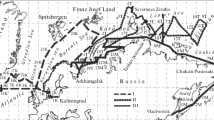Abstract—
The article presents the results of measurements of Pb, Cd, Cu, Zn, Ni, Co Cr, As, and Fe concentrations in atmospheric aerosols in the surface layer over the Kara Sea. The data were collected on 12 segments of a cruise of the R/V Akademik Mstislav Keldysh in September–October 2011. The trace element contents in atmospheric aerosol samples were determined by atomic absorption spectrometry with electrical and thermal atomization and automatic background correction. The dataset was analyzed in relation to the direction in which air masses moved into the study area; the direction was determined from the reverse motion trajectories of air particles. It is demonstrated that concentrations of pollutants increase in air masses coming off the continent and decrease in air masses coming off the ocean. The enrichment of Arctic aerosols in trace elements is calculated.



Similar content being viewed by others
REFERENCES
L. V. Burtseva and E. S. Kon’kova, “Lead and cadmium in atmospheric air and sediments in background regions of the East European Area,” Probl. Ekol. Monit. Model. Ekosist. 27 (2), 59–70 (2016).
A. P. Vinogradov, “The average content of chemical elements in the general types of erupted rock of the earth’s crust,” Geokhimiya, No. 7, 555–571 (1962).
GN 2.1.6.1338–03. Maximum Permissible Concentration of Pollutants in Atmospheric Air of Residential Areas with a Supplement (Moscow, 2003) [in Russian].
N. I. Golubeva, G. G. Matishov, and L. V. Burtseva, “Heavy metal pollution of the atmosphere in open areas of the Barents and White seas,” Dokl. Earth Sci. 387, 1071–1074 (2002).
N. I. Golubeva, L. V. Burtseva, G. G. Matishov, and G. V. Il’in, “The results of measurements of heavy metals in atmospheric aerosols in the open areas of the Arctic Seas in 2009–2010,” Dokl. Earth Sci. 453, 1090–1093 (2013).
S. A. Gromov, “Meteorological aspects in background monitoring of atmospheric pollution,” in Monitoring of the Background Pollution of Environments (Gidrometeoizdat, Leningrad, 1989), No. 5, pp. 126–135.
B. N. Demin, A. P. Graevskii, A. S. Demeshkin, et al., Dynamics of Environmental Pollution in Economic Areas of Russian Industries in Svalbard Archipelago (Barentsburg Settlement and Adjacent Territories) in 2002–2010 (Arctic and Antarctic Research Institute, St. Petersburg, 2011) [in Russian].
V. N. Lukashin and A. N. Novigatsky, “Chemical composition of aerosols in the near-water surface atmospheric layer of the central Caspian Sea in the winter and autumn of 2005,” Oceanology (Engl. Transl.) 53, 727–738 (2013).
L. V. Kirichenko and V. I. Kozlov, “Use of thin fiber filters for determination of mass concentrations of dust and single chemical elements in air,” Tr. Inst. Prikl. Geofiz., No. 21, 32–37 (1976).
RD 52.04.186-89. Manual for Monitoring of Atmospheric Pollution (Gidrometeoizdat, Leningrad, 1991) [in Russian].
“RD 52.44.593-97. Methodological recommendations. Determination of the mass concentration of heavy metals in air aerosols. Measurement using atomic absorption spectrophotometry with flameless atomization,” in The Federal List of the Approved Methods for Monitoring of Environmental Pollution by October 1, 2009 (All-Russia Research Institute of Hydrometeorological Information–World Data Centre, Obninsk, 2009) [in Russian].
R. R. Draxler and G. D. Rolph, The HYSPLIT (HYbrid Single-Particle Lagrangian Integrated Trajectory) (NOAA Air Resources Laboratory, Silver Spring, 2003). http:// ready.arl.noaa.gov/HYSPLIT.php.
N. Golubeva, L. Burtseva, S. Gromov, and M. Felitsin, “The results of investigation of contamination of atmospheric air of the open areas of the Barents and White seas with heavy metals,” in The Second AMAP International Symposium on Environmental Pollution of the Arctic, Rovaniemi, Finland, October 1–4, 2002, Abstracts of Papers, AMAP Report no. 2002:2 (Arctic Monitoring and Assessment Program, Oslo, 2002), No. P-M11.
J. M. Pacyna, E. G. Pacyna, and W. Aas, “Changes of emissions and atmospheric deposition of mercury, lead, and cadmium,” Atmos. Environ. 43, 117–127 (2009).
J. M. Pacyna and E. G. Pacyna, “Sources of heavy metals, inventories, and future scenarios,” in The Second AMAP International Symposium on Environmental Pollution of the Arctic, Rovaniemi, Finland, October 1–4, 2002, Abstracts of Papers, AMAP Report no. 2002:2 (Arctic Monitoring and Assessment Program, Oslo, 2002), No. O-006.
K. Tørseth, W. Aas, K. Breivik, et al., “Introduction to the European Monitoring and Evaluation Programme (EMEP) and observed atmospheric composition change during 1972–2009,” Atmos. Chem. Phys. 12, 5447–5481 (2012).
O. Travnikov, I. Ilyin, O. Rozovskaya, et al., Long-Term Changes of Heavy Metal Transboundary Pollution of the Environment (1990–2010): EMEP Status Report 2/2012 (Meteorological Synthesizing Centre-East, Moscow, 2012).
Health Risks of Heavy Metals from Long-Range Transboundary Air Pollution (World Health Organization Regional Office for Europe, Copenhagen, 2007).
ACKNOWLEDGMENTS
The authors express their sincere gratitude to the expeditionary supervisor of cruise 59 of the R/V Akademik Mstislav Keldysh M.V. Flint, as well as to S.A. Mosharov of the Shirshov Institute of Oceanology, Russian Academy of Sciences, who provided the air samples used for analysis in this study.
Author information
Authors and Affiliations
Corresponding author
Additional information
Translated by A. Carpenter
Rights and permissions
About this article
Cite this article
Golubeva, N.I., Burtseva, L.V. & Gromov, S.A. Heavy Metals in Atmospheric Air in the Kara Sea Water Area in September–October 2011. Oceanology 58, 870–878 (2018). https://doi.org/10.1134/S000143701806005X
Received:
Accepted:
Published:
Issue Date:
DOI: https://doi.org/10.1134/S000143701806005X




